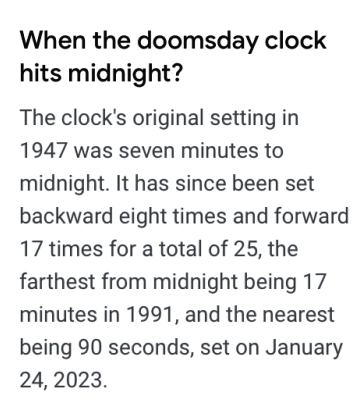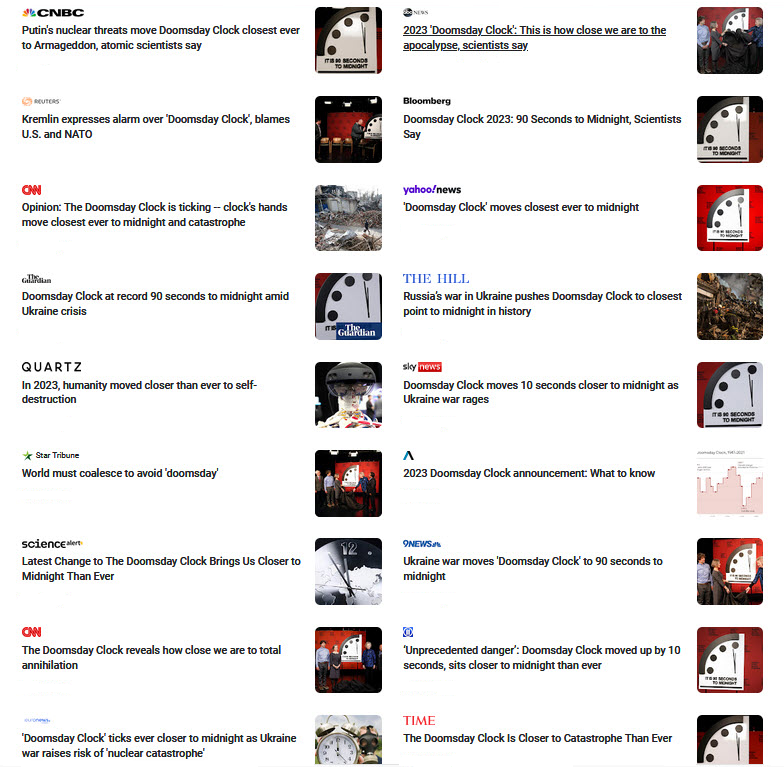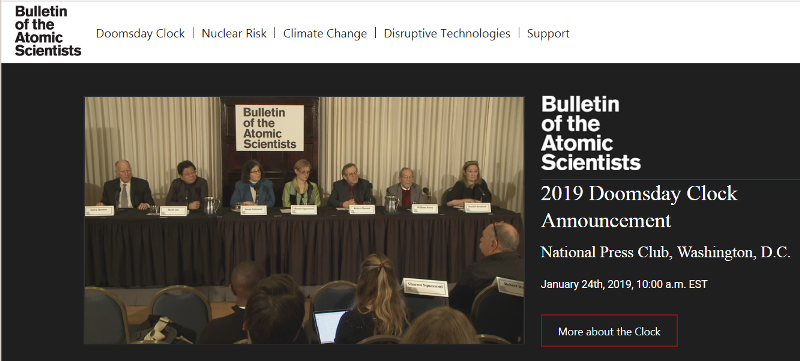File:A Stark Nuclear Warning from William J Perry.png: Difference between revisions
Siterunner (talk | contribs) No edit summary |
Siterunner (talk | contribs) No edit summary |
||
| (4 intermediate revisions by the same user not shown) | |||
| Line 11: | Line 11: | ||
:: Book review by California Governor Jerry Brown | :: Book review by California Governor Jerry Brown | ||
:: * http://www.nybooks.com/articles/2016/07/14/a-stark-nuclear-warning | :: <small>* http://www.nybooks.com/articles/2016/07/14/a-stark-nuclear-warning</small> | ||
\\\\\\\\\\\\\\\\\\\\\\\\\\\\\\\\\\\\\\\\\\\\\\\\\\\\\\\\\\\\\\\\\\\\\ | ::\\\\\\\\\\\\\\\\\\\\\\\\\\\\\\\\\\\\\\\\\\\\\\\\\\\\\\\\\\\\\\\\\\\\\\\\\\\\\\\\\\\\\\\\\\\\\\\ | ||
Latest revision as of 20:13, 27 January 2023
The Clock Is Ticking ...
A Stark Nuclear Warning
At the Nuclear Brink
- By former U.S. Defense Chief, William Perry
- Book review by California Governor Jerry Brown
- \\\\\\\\\\\\\\\\\\\\\\\\\\\\\\\\\\\\\\\\\\\\\\\\\\\\\\\\\\\\\\\\\\\\\\\\\\\\\\\\\\\\\\\\\\\\\\\
2023
"Danger, Danger"
- The Atomic Scientists Clock of Doom Is a Ticking Timebomb
- Flashback to the year 1991 when the Atomic Scientists clock was 'farthest from midnight'
- SJS / GreenPolicy360 Siterunner:
* https://www.greenpolicy360.net/w/File:Jerry_Brown_92_Presidential_Platform_We_the_People.jpg
2019
2018 / 2017
Nuclear Weapons / Nuclear Weapons Proliferation
\\\\\\\\\\\\\\\\\\\\\\\\\\\\\\\\\\\\\\\\\\\\\\\\\\\\\\\\\\\\\\\\\\\\\
GreenPolicy360 & Strategic Demands:
Time for "New Definitions of National Security"
“The unleashed power of the atom has changed everything, save our modes of thinking.”
- --Albert Einstein
My Journey at the Nuclear Brink
by William J. Perry, with a foreword by George P. Shultz
Stanford Security Studies, 234 pp., $85.00; $24.95
New York Review of Books
July 14, 2016 Issue
Reviewed by Jerry Brown
I know of no person who understands the science and politics of modern weaponry better than William J. Perry, the US Secretary of Defense from 1994 to 1997. When a man of such unquestioned experience and intelligence issues the stark nuclear warning that is central to his recent memoir, we should take heed.
Perry is forthright when he says: “Today, the danger of some sort of a nuclear catastrophe is greater than it was during the Cold War and most people are blissfully unaware of this danger.”
William J. Perry, "A National Security Walk Around the World” 2016 Drell Lecture, Center for International Security and Cooperation, Stanford University, February 10, 2016.
In clear, detailed but powerful prose, Perry tells the story of his seventy-year experience of the nuclear age.
\\\\\\\\\
Beginning with his firsthand encounter with survivors living amid “vast wastes of fused rubble” in the aftermath of World War II, his account takes us up to today when Perry is on an urgent mission to alert us to the dangerous nuclear road we are traveling.
Reflecting upon the atomic bombing of Hiroshima and Nagasaki, Perry says it was then that he first understood that the end of all of civilization was now possible, not merely the ruin of cities.
He tells us that the nuclear danger is “growing greater every year” and that even a single nuclear detonation “could destroy our way of life.”
He asserts it is only “old thinking” that persuades our leaders that nuclear weapons provide security, instead of understanding the hard truth that “they now endanger it.”
\\\\\\\\\
As a defense insider and keeper of nuclear secrets, he is clearly calling American leaders to account for what he believes are very bad decisions, such as the precipitous expansion of NATO, right up to the Russian border.
“The descent down the slippery slope began, I believe, with the premature NATO expansion, and I soon came to believe that the downsides of early NATO membership for Eastern European nations were even worse than I had feared” (p. 152)
Within ten short years after the end of World War II, both the Soviet Union and the United States had developed hydrogen bombs, which increased by a million times the destructive capability of the conventional bombs that had been available during World War II. Children were taught to “duck and cover” under their desks and public buildings prominently displayed signs showing where to take shelter in case of nuclear attack [StratDem's editor well remember the "duck and cover" school exercises of the 1960s missile crisis era]
Perry recalls that it was the fear of nuclear annihilation during the cold war that unleashed the billions of federal dollars that supported the secret defense work that began in Silicon Valley and then propelled it forward. [Via ARAPNET research intended to ensure command-and-control survivability in the event of nuclear war]
\\\\\\\\\
Perry says it was by luck that we avoided a nuclear holocaust in the Cuban crisis. Years later, we found out that there were some additional and dangerous circumstances that might have pushed us into nuclear war.
"The Man Who Saved the World", Secrets of the Dead, PBS, October 23, 2012
Perry points out several particularly troubling aspects of the crisis. There were, he writes, advisers on both the Soviet and US sides who wanted to rush into war. The media, for their part, treated the crisis as “a drama of ‘winning’ and ‘losing.’” Finally he observes that political leaders seemed to gain approval with the public based on their willingness to initiate a war.
As a result, an even more sophisticated competition began, in nuclear warheads and in the vehicles to deliver them.
\\\\\\\\\
Perry's work at Sylvania, then ESL as a founder, was at the forefront of private defense contractors working for the US defense establishment on nuclear war issues. ICBMs, nuclear bombs, ballistic missile defense systems, and supersonic aircraft, Perry and ESL were in the vanguard of the weapons complex.
With the election of Jimmy Carter in 1976, the new secretary of defense asked Perry to become undersecretary of defense for research and engineering. Perry directed the US strategy that had three principal elements: (1) intelligent sensors to locate all enemy forces in real time; (2) smart weapons that could strike targets with great precision; and (3) stealth systems that could evade enemy radar.
America looked to offset the Soviet military with weapon systems that included the F-117 and B-2 stealth bombers, smart artillery shells, short- and long-range cruise missiles, and reconnaissance aircraft.
Perry was responsible for important technological advances with respect to US nuclear forces. He helped launch the B-2, a strategic nuclear bomber, capable of use in both nuclear and nonnuclear missions; revitalized the aging B-52 with air-launched cruise missiles; put the Trident submarine program back on track; and made an ill-fated attempt to bring the MX ICBM, a ten-warhead missile, into operation.
Perry writes that he acceded to the political pressure to keep up with the other guy. Then as now, Perry writes, he believed that America would possess all the deterrence it needs with just one leg of the so-called triad: the Trident submarine.
Perry's position is that the US ICBM force is redundant. Indeed the danger of starting an accidental nuclear war as a result of a false alarm outweighs its deterrent value.
\\\\\\\\\
Perry tells us that parity is “old thinking” because nuclear weapons can’t actually be used—the risk of uncontrollable and catastrophic escalation is too high. They are only good for threatening the enemy with nuclear retaliation.
In My Journey at the Nuclear Brink is a rare accounting of the last six decades of American policy in the new age of nuclear danger.
Since the book’s publication, the dangers identified by Perry have only intensified: the latest US defense budget proposes spending $1 trillion on nuclear modernization over the next several decades. This modernization plan contemplates a complete update of our nuclear triad, including new cruise missiles, nuclear submarines, ICBMs and bombers.
The Russian defense minister recently announced in response that Russia will “bring five new strategic nuclear missile regiments into service.” This comes after President Putin revealed that Russia will add more than forty new intercontinental ballistic missiles to its nuclear arsenal. And, just this month, as the US broke ground on a future missile defense site in Poland and formally activated a missile defense site in Romania, Putin warned: “Now after the placement of these missile defense elements, we have to think how to neutralize the threats for the security of the Russian Federation...”
Update: March 2018 -- https://www.strategicdemands.com/nuclear-ratcheting-2/
https://www.strategicdemands.com/nuclear-issues-cold-war-2-0/
············································································
Read More
~ Jon B. Wolfstahl, Jeffrey Lewis and Marc Quint, The Trillion Dollar Nuclear Triad, James Martin Center for Nonproliferation Studies, Monterey, January 2014
~ Ilya Arkhipov and Marek Strzelecki, Putin Warns NATO Missile Shield is Threat to Peace in Europe, Bloomberg, May 13, 2016. Existing US law allows for the deployment of a missile defense system to prevent a “limited ballistic missile attack” (see www.congress.gov/106/plaws/publ38/PLAW-106publ38.pdf). The word “limited” was meant to prevent the deployment of a large missile defense system aimed at Russia or China. The proposed National Defense Authorization Act for Fiscal Year 2017 contains a particularly dangerous provision introduced by Senator Ted Cruz that strikes the word “limited” from existing law and thereby lays the groundwork for an expanded missile defense system directed at Russia and China. Such action would have a hugely destabilizing impact upon an already precarious world order.
\\\\\\\\\
It is conspicuous how most all US foreign policy think tanks, Brookings most prominently given its leadership, push an adversarial policy in Europe. Perry point to the the continued expansion of NATO with consequences and a George Kennan quote appears prescient:
As George Kennan told The New York Times in 1998: “I think NATO expansion is the beginning of a new cold war. I think the Russians will gradually react quite adversely and it will affect their policies. I think it is a tragic mistake. There was no reason for this whatsoever. No one was threatening anybody else. This expansion would make the Founding Fathers of this country turn over in their graves. We have signed up to protect a whole series of countries, even though we have neither the resources nor the intention to do so in any serious way.”
···········································································································
Governor Brown concludes his review of Perry's book with ominous words:
No one I have known, or have even heard of, has the management experience and the technical knowledge that William Perry brings to the subject of nuclear danger. Few have his wisdom and integrity. So why isn’t anyone paying attention to him? Why is fear of a nuclear catastrophe far from the minds of most Americans? And why does almost all of official Washington disagree with him and live in nuclear denial? Perry himself may provide the answer:
Our chief peril is that the poised nuclear doom, much of it hidden beneath the seas and in remote badlands, is too far out of the global public consciousness. Passivity shows broadly. Perhaps this is a matter of defeatism and its cohort, distraction. Perhaps for some it is largely a most primal human fear of facing the “unthinkable.” For others, it might be a welcoming of the illusion that there is or might be an acceptable missile defense against a nuclear attack. And for many it would seem to be the keeping of faith that nuclear deterrence will hold indefinitely — that leaders will always have accurate enough instantaneous knowledge, know the true context of events, and enjoy the good luck to avoid the most tragic of military miscalculations.
While many complain of the obvious dysfunction in Washington, few see the incomparably greater danger of “nuclear doom” because it is hidden and out of public consciousness. Despite an election year filled with commentary and debate, no one is discussing the major issues that trouble Perry. It is another example of the rigid conformity that often dominates public discourse. Long ago, I saw this in the Vietnam War and later in the invasion of Iraq: intelligent people were doing mindless — and catastrophic—things. “Sleepwalking” is the term historians now use for the stupidities that got European leaders into World War I and for the mess they unleashed at Versailles. And sleepwalking still continues as NATO and Russia trade epithets and build their armies and Moscow and Washington modernize their nuclear overkill. A new cold war.
Fortunately, Bill Perry is not sleepwalking and he is telling us, in My Journey at the Nuclear Brink, to wake up before it is too late. Anyone can begin by reading his book.
\\\\\\\\\\\\\\\\\\
Read More at GreenPolicy's associated site, Strategic Demands
Many experts agree, mostly off record for professional advancement, with William Perry and his book's life-and-death assessment, as presidents follow the political and highly dangerous path of sizing our nuclear force to achieve “parity” with Russia. This continued competition that waned for years after the end of the Soviet Union is now reasserting itself. Another 'superpower', China, is becoming visible and entering the nuclear arena with a response of strategic/tactical nuclear weapons revealing systems such as their version of the F-35 and their version of MIRV'd ICBMs. Three geo-political powers are now ramping up another era of nuclear rivalry and "such a competitive and mindless process leads to escalation without end".
What Are the Odds -- http://strategicdemands.com/what-are-the-odds/
\\\\\\\\\\\\\\\\\\
Governor Brown's Nuclear Warning
(GreenPolicy Siterunner / SJS: Having worked formerly with the Governor on policy formation and presidential campaigns, I look deeply at the nuclear question as does the Governor. We are of like mind as to the danger of catastrophe and the escalating risks of nuclear weapons proliferation. A renewed nuclear arms race is upon us, west and east, the U.S., Russian Federation, China, and alliance partners, allies and adversaries. Rising tensions and risks of nuclear use are a reality that must be faced.)
Nuclear Brink / End of Times
- Posted on June 26, 2016 | By SJS
Last week Strategic Demands wrote of President Obama and his National Security counsel as they prepared to leave office and leave behind the power of the White House to shape security policy. This week we continue on the theme of the president’s legacy and strategic nuclear risks by again considering My Journey at the Nuclear Brink by William Perry.
The legacy of nuclear weapons looms large in recent history and, going forward, a policy of projected power with nuclear dominance is again moving to the top of the Pentagon’s capabilities. The “modernization” and expansion of nuclear force strategic and tactical capabilities and options looks to be a lasting legacy of the Obama administration.
After our story about the last week’s of the US President’s term in office, and last executive actions he could order, we were surprised and gratified to see a Letter to the President from top scientists urging him, in his last days in office, to take US land-based nuclear missiles off hair-trigger alert and remove launch-on-warning options. We agree even as nuclear question grow and the nuclear weapons complex proliferates.
A trillion-dollar nuclear weapons complex and systems “modernization” has been set in motion under the president’s watch and the newest capabilities, across the US nuclear weapons triad of land-, air- and sea-based nuclear weapons platforms and strike capabilities, will be expanding dramatically if all goes according to plan in the coming budgeted years of development and deployment.
We spoke of the Oval office and the daily morning POTUS briefings and what it could be like as the President meets to hear the daily reports of crisis and executive decisions and orders that could be issued, or must be issued. Among the day-to-day brews the cauldron of potential global destruction, a “national security” issue if there ever was an accurate definition of what constitutes “national security” and, to be matter of fact, “environmental security” because any outbreak of nuclear conflict, as William Perry’s recent memoir points out with a dire prediction, could bring on ‘the end times.’
As the Governor of California, Jerry Brown steps aside from his daily tasks to read and review the life’s work of a man, William J. Perry, who can be said to be best in knowing “the science and politics of modern weaponry” better than anyone.
In your StratDem’s editor’s case, this review of Perry’s book has special relevance in that I was a close advisor to the Governor and have known him since the 1970s. In 1992 we worked together to draft the presidential campaign’s platform. I have seen Jerry Brown’s mind at work and the following thoughts he expresses are well worth consideration.
When Governor Brown urges us to listen to William Perry, we should listen — and listen carefully when Perry says:
-- the nuclear danger is “growing greater every year” and that even a single nuclear detonation “could destroy our way of life.”
-- it is only “old thinking” that persuades our leaders that nuclear weapons provide security, instead of understanding the hard truth that “they now endanger it.”
○
File history
Click on a date/time to view the file as it appeared at that time.
| Date/Time | Thumbnail | Dimensions | User | Comment | |
|---|---|---|---|---|---|
| current | 15:41, 22 June 2016 | 579 × 185 (55 KB) | Siterunner (talk | contribs) | www.nybooks.com/articles/2016/07/14/a-stark-nuclear-warning |
You cannot overwrite this file.
File usage
The following 6 pages use this file:





